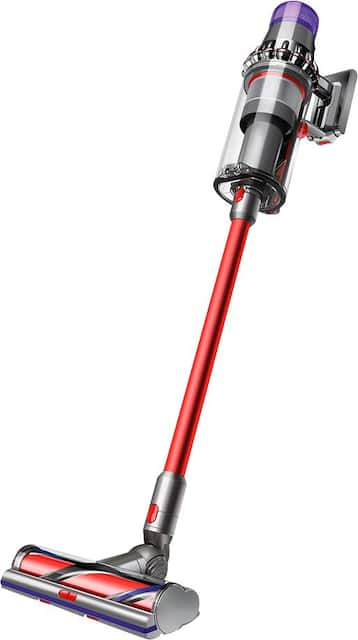Dyson V8 Fluffy Vacuum (Red)
Cord-free. Hassle-free. The most powerful suction of any cord-free stick vacuum. Additional cleaner head invented for hard floors.
All features
Up to 40 minutes of run time*
Powerful suction for everyday, quick cleans.
Two power modes
The right power when you need it. Two modes to choose from to suit any task.
Easily reaches up high
Lightweight and ergonomic to clean hard-to-reach places.
Quickly transforms to a handheld
Changes to a handheld vacuum cleaner and back again in just one click.
‘Point and shoot’ hygienic bin emptying
The ‘point and shoot’ mechanism hygienically ejects dust and debris in one action, so there’s no need to touch the dirt.
Docking station
Tidily stores and recharges your Dyson V8 vacuum, so it’s always ready for use.
Additional information
| Height | 8.27 in |
|---|---|
| Length | 10.62 in |
| Width | 6.06 in |
| Weight | 5.7 lb |






by Peedy
Love this vacuum. It is lightweight and powerful, easy to empty the canister and the variety of tools that come with it are awesome. I have a vacuum attachment to vacuum my dogs and because the vacuum is low noise they are good with it. Very happy with my purchase.
by Mike
I bought this model approximately one month ago. My Bissell was no longer doing the job. This Dyson V8 Animal Stick has been awesome. Lightweight. Great suction. Love ditching the cord! Battery life has been great for my small place. Overall impressed and happy I finally purchased a Dyson.
by Óscar
It’s a good product. Needs some ergonomic design to protect your wrist. Much better than the traditional cord vacuum. I hope the quality will be good in a long term. Needs a better self support for charge purposes, instead of the charge station to be attached on the wall. A little pricey. I recommend it.
by Tenita
How I ever lived without this vacuum is beyond me. I love the ease in which I can clean everything. Yes it’s pricey but it’s worth every penny. Do yourself a favor get a Dyson vacuum.
by Anthony
I bought this about a month ago and have not stopped vacuuming because I love it so much. Regular high suction works great for everyday. I have 2 toddlers that leave crumbs everywhere and now I don’t stress about them making a mess. Cordless is truly life changing.
by Pink
This vacuum has very good suction power and is very easy and light to maneuver around the entire house. The reason I gave 4 stars is that it does not move swiftly on my carpeted stairs as it moves on the wooden floor. But otherwise, its an amazing product.
by Chris
We have used other brands/ models and have not been satisfied.
They usually do not adapt from low to high surfaces and lack longevity ( worn out wheels, motors etc.) The V8 is exceptional for the hair produced by our two German Shepherds. The two heads and adjustable suction settings handles are very accommodating.
Only downside is the battery life is limited, but cordless mobility is invaluable.
by William
Lightweight and powerful suction without the restriction of a power cord. This Dyson is so easy to maneuver around furniture.